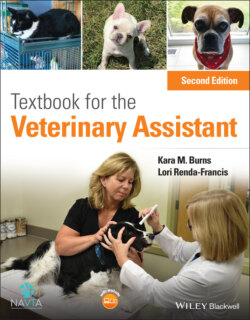Читать книгу Textbook for the Veterinary Assistant - Lori Renda-Francis - Страница 67
Avian restraint
ОглавлениеAs with all animals, proper restraint techniques for birds are important for the safety of the handler and the person performing examinations or treatments, but most importantly for the safety and well‐being of the patient. Restraint is a large stressor for avian patients, so knowing the avian patient and proper restraint and capture techniques will help to decrease pain and stress resulting from restraint.
All escape routes should be closed, and the room should be sealed. Hiding places to which the bird may flee should be identified and closed off. To capture and restrain an avian patient, it is recommended to use a towel. Towels of different sizes relative to the size of the bird are indicated. Using a towel to capture a bird helps to reduce fear of hands in the future. Gloves are not recommended, as a fear of hands may develop with gloves and the wearer loses much of their tactile sensation which is extremely important when handling birds. A slow approach with the towel in hand is best. Do not try to capture a bird that is sitting on the owner, as this may result in behavioral issues of the bird toward the owner and may result in the bird biting or attacking the owner. Remember to use a calm and soothing tone when approaching a bird. Confidence should be displayed, especially when trying to capture and restrain a large bird – they can detect fear and hesitation.
The hand (in the towel) should grasp the head of the bird toward the cervical (lower) end of the head but do not choke around the neck. Hold the sides of the head firmly, but insure the bird is able to breathe. Oftentimes, letting the bird bite the excess towel offers a distraction. For small birds, use the remainder of the hand to control the body and make sure the towel is wrapped around the bird to control the wings and feet (Figure 4.11). Larger birds should remain controlled with the opposite hand holding the towel that is wrapped around the body. The person restraining the bird should be monitoring the bird’s respirations and stress level the entire time it is restrained. Observe the avian patient closely for signs of stress, hypoxia, and hyperthermia. Hands should be moved accordingly to allow the examiner to exam the bird at a faster pace.
Restraint is a very stressful experience for a bird. Allow the examiner to move as quickly as possible to insure the bird is restrained as little as possible. It is typical for a bird to show signs of stress when the restraint is released and the bird is placed back in its carrier. Open beak breathing, holding wings away from body, and fluffing of feathers may be exhibited so be aware if the bird exhibits these behaviors for a while after returning to its cage. However, normally the bird should recover rather quickly,
Figure 4.11 Restraining a bird with a towel. Courtesy of Kara M Burns, LVT, VTS (Nutrition).
